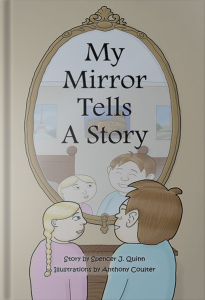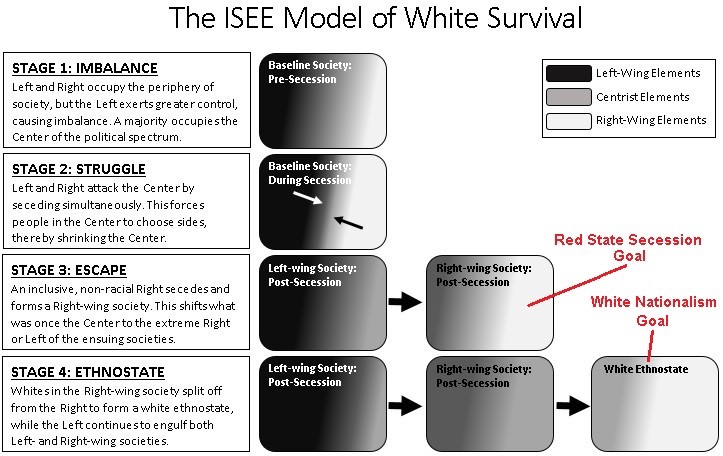White Advocacy vs. White Nationalism
If there is a friendly divide within the dissident Right, it might very well be between White Nationalists and white advocates. The difference between the two groups should be plain: the former seek separation and self-determination, and the latter political advocacy in a multiracial country. Neither group has much cause to squabble, especially today when both find the present situation intolerable for roughly the same reasons. Both are open about white identity and race realism, both have no illusions about the dangers of non-white political leadership of white nations, and both have essentially the same enemies. Only their end goals, and perhaps the Jewish Question, remain as sticking points, with White Nationalists supporting various forms of counter-Semitism and white advocates remaining steadfastly Judeo-neutral — at least in public.
These are not impossible hurdles to overcome, largely because they are so superficial. In a future in which demographics make separation impossible, today’s nationalists and advocates would still work together. And in a future which shines on separation, there would be no reason why advocates wouldn’t become nationalists themselves. The famous quote attributed to Benjamin Franklin during the signing of the Declaration of Independence comes to mind: “We must all hang together, or assuredly we shall all hang separately.” Anti-whites will see any differences between these groups as the sheerest of nuance and will press on against them regardless. Except in extremely rare and bizarre cases, White Nationalists and advocates make natural allies.
Assuming that both sides operate in good faith and eschew ulterior motives, what sets them apart aside from their stated aims? Speaking of the current situation in the United States, it seems that many white advocates are loath to part with their American identity. Perhaps they connect with the land or the rich American mythos? Perhaps their families have been in America for generations or are descended from the nation’s founding stock? Or perhaps they are optimists regarding the American dream, believing that with proper leadership, even disparate peoples can get along? America has been multiracial since its inception and still remains a place of great opportunity and high standards of living. Why won’t this continue? A bloody civil war was fought to keep this country together, and some 630,000 men have died for its flag since then. Are we to say they all died for nothing?

You can buy Greg Johnson’s Toward a New Nationalism here.
White Nationalists, on the other hand, have more of a post-American perspective. But a post-American perspective is not necessarily an anti-American one — and most often isn’t. White Nationalists typically don’t hate America the way the hard Left does because they don’t see white Americans as inherently evil due to the sins of racism, anti-Semitism, sexism, or the like. Many simply want to get away from America — and take as many white Americans as possible along with them — in order to start the country over the way the Founding Fathers had intended. A post-American identity could be seen as a return to the original American identity as envisioned over 200 years ago.
Yet, how much any functional white offshoot nation would resemble the original United States is an open question. Along with the freedom this post-American identity affords come some problems, which are noticeably lacking in the white advocacy camp. “Post-American” is a vague term and can include many kinds of identities beyond the original American one — for example, fascists, Nazis, Southern nationalists, Christian nationalists, anti-Semites, pagans, and others. This means that although White Nationalists may be united in terms of race, they might very well not be united when it comes to other important matters, not least being where and how to govern. This could lead to a certain amount of bickering, to say the least. White advocates quite naturally don’t have this problem since they are committed to working within the current system, which they hope to make less anti-white. This may or may not be a realistic goal, but white advocates should be commended for their single-minded pursuit of it.
As for our fighting men’s past sacrifices, however, nothing lasts forever. White Nationalists of all stripes are well served not to take this argument to heart. It could be said that the men who died in America’s twentieth-century wars did so for the sake of American international dominance. This could be for good or for ill, but according to this train of thought, it can’t be said that they died for nothing. America was internationally dominant for many years, after all. These men made sacrifices for their country as it existed at the time. But now, with American demographics changing so rapidly, it could justly be said that this is not the same country as it was even a mere 25 years ago. If the veterans of this nation’s twentieth-century wars could see how far twenty-first century America has fallen in terms of corruption and degeneracy, would they have gone to war? Probably not. White recruitment in the US military is at an all-time low, and rightfully so. After the COVID crackdowns, the Summer of Floyd, the stolen 2020 election, the January 6 gulags, and the advent of critical race theory and transgenderism in a US military already compromised by feminism and affirmative action, what is left to fight for?
It seems White Nationalists and white advocates also differ over practical concerns. To many, the very idea of the United States splintering — peacefully or not — into autonomous factions seems more like dystopian fiction than reality. White advocates seem comfortable banking on it not happening. And yet, how else could the United States end up? This is the dilemma I find myself pondering all the time. Yes, bad signs are everywhere, and they’re getting worse; people are fed up. But is it enough to force secession? It hasn’t yet. What is our threshold of tolerability? Will it require another depression? A major war? A nuclear attack? An artificial intelligence apocalypse? I have no answers. This is why I can never be too critical of a white advocate who’d rather correct a flawed system than dream of a better one. This flawed system is real, as opposed to a bona fide white ethnostate in North America — which, as of January 2024, is not. I have to respect this.
On the other hand, bone fide white ethnostates have indeed existed in North America the past, namely the 13 states which made up the original United States. We all know that the 1790 Naturalization Act restricted immigration to free whites of good character. White identity was baked so deeply into the cake back then that no one felt it needed to be sanctioned in an official document such as the US Constitution. Of course, the United States of America would be a white ethnostate. What other kind of state was there back then? So this, along with the brief and tragic life of the Confederacy and perhaps the pro-nativist 1920s, do establish a precedent.
As far as the future goes, the one way we can guarantee never establishing a white ethnostate in North America is by giving up on it now. Is this not what dreams are made of? And if we are going to dream, why not dream big? It’s fine to manage one’s expectations. But there is also nothing wrong with envisioning a drastic yet sensible solution to our current problems — a solution that works in accord with the biological realities of race. If we’re always thinking about it — and theorizing and wargaming it — then maybe we’ll be prepared to act when opportunities arise? Maybe we’ll have a better idea of what to do when the time comes? Or better yet, maybe we’ll know how to make those opportunities arise ourselves? Let’s face it, an ethnostate of 40 million racially-based white Americans with an explicitly pro-white constitution is the best solution to the surfeit of problems caused by globalism, multiracialism, and the Left’s cultural triumph. Why should we settle for anything less?

You can buy Spencer J. Quinn’s novel Charity’s Blade here.
Another practical concern — which is harder for a White Nationalist to disregard — is the issue of population transfer. How would one respond to a white advocate who’d rather not initiate changes that require millions to relocate, willingly or not? There’s no way around it. If a white ethnostate were to be formed in North America in this century, it would have to come on the heels of some great and tragic cataclysm, or as an evolutionary outcome of a non-racial separatist movement such as Red State Secession. In the former case, violence, deprivation, and mayhem would likely cause many on both sides to urgently relocate, thus doing the ethnonationalist’s work for him in a relatively short amount of time. This has precedent in the chaotic 1947 Partition of India and the subsequent war between India and Pakistan during which millions of Hindus fled east into India and millions of Muslims fled west into Pakistan. Yes, this is a solution, but not a happy one given all the bloodshed and trauma. I think I speak for many White Nationalists when I say I’d prefer a peaceful resolution to our troubles, one that does not involve warfare or ethnic cleansing.
This is why I want whites to pursue the latter option: Red State Secession. In other essays, I’ve discussed how a genuine grassroots White Nationalist movement can emerge in an independent red state. According to my ISEE Model of White Survival, whites need to escape first and then reestablish themselves in the friendlier milieu of a Right-wing, majority white state. “ISEE” stands for “Imbalance, Struggle, Escape, and Ethnostate,” and here is the flowchart for all you visual learners out there:
The advantages of the ISEE model is that it requires no violence, no ethnic cleansing, and allows for Greg Johnson’s “slow cleanse” to occur. In a peacefully-established ethnostate, non-whites would be forced to give up their political rights, but not their human rights. Furthermore, lack of opportunity would encourage them to leave. Over time, an ethnostate would emerge. Yes, the process will be slow. But would it be any slower than using political means to convince American blacks, Jews, Hispanics, and Muslims to give up on their winning anti-white coalition? A white advocate would have to answer for that.
Another major difference between White Nationalists and white advocates involves what I call the dignity of restraint — and this is both good and bad. Decidedly not talking about the Jewish Question requires a certain amount of discipline which seems to inoculate one against bad optics. This might be one reason why white advocates operate with so much class. This is not to say that White Nationalists cannot do the same. Many do, despite being able to talk about whatever they want. Unfortunately, however, many do not. White Nationalists seem to have looser rules about what they can and cannot discuss. This makes for a bigger tent, one that ultimately takes in all types.
But the dignity of restraint cuts both ways. The Jewish Question is the most confounding yet urgent issue of our time. Why not talk about it? It’s one thing to obsess over Jews. It’s something else entirely to speak reasonably and accurately about them. Avoiding the JQ leads one to a rather incomplete perspective on today’s world. This will prove disappointing for many, because the solutions presented by white advocates will be equally incomplete. A white advocate will often point to the ethnomasochism or oikophobia of whites themselves as the primary cause of our troubles. If whites could only regain their racial pride and lose the fear of collectively asserting themselves, then we will get much closer to a more sustainable future.

You can buy Spencer J. Quinn’s My Mirror Tells a Story here.
A white advocate may also view many, if not most, Jews as white. They certainly look white, in many cases. After centuries of living in Europe, they have also absorbed a great deal of Western culture in their everyday lives and accomplished great things. The significant Jewish contributions in classical music is a great example of this. Furthermore, it’s undeniable that some genetic exchange has occurred between whites and Jews throughout the centuries. Why alienate a certain group of people who may be more similar to whites than different?
All of this is reasonable. However, to ignore the fact that non-whites, and especially Jews, expend great time and energy limiting the freedom of whites and punishing those who displease them is to avoid a crucial reason why so many whites are submissive to non-whites to begin with. There is a tremendous amount of evidence pointing to the ways in which Jews in particular act with great malice against whites and promote all manner of dysgenic behavior in traditionally white countries that they themselves would never engage in in Israel. To ignore all this is to avoid finding workable solutions to today’s problems. Is this an acceptable tradeoff for the sake of good optics?
I think the core difference between White Nationalists and advocates is that the White Nationalist strives to be correct — and thereby takes the risk of being wrong. Meanwhile, the white advocate strives not to be wrong, thereby taking fewer risks in the first place. Pick your poison.
As for my stance on this, I choose White Nationalism while keeping a healthy respect for white advocacy. As with a lot of things, I follow my gut. Czeslaw Milosz would call it “a revolt of the stomach.” I simply have a visceral dislike of being ruled by racial outsiders. Non-whites, for the most part, do not have the same temperament and IQ distribution as whites. Their loyalty will always be in question — and, if history is any indication, are prone to behave as hostile elites. This does not mean I hate non-whites or wish them ill; I simply do not trust non-whites with the will to act in white interests once they attain power — and ultimately, it won’t matter if whites advocate for themselves or not.





